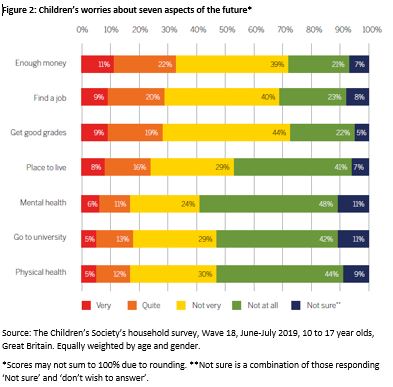Wellbeing of children in the UK: influential factors and fears about the future
Today’s blog is from Dr Louise Moore who is a Senior Researcher at The Children’s Society working on wellbeing and mental health. She reflects on the findings from the charity’s most recent annual Good Childhood Report, which looks at the subjective wellbeing of children in the UK.
Since The Children’s Society started its programme of work on the wellbeing of children in 2005, there have been vast changes to children’s lives. Not least, the rise in their use of social media, and changes to schools.
How do these changes make young people feel? This Wednesday, The Children’s Society published its eighth Good Childhood Report looking at the subjective wellbeing of children in the UK. The report makes use of the most robust data sources on this issue, including the Millennium Cohort Study (MCS) and Understanding Society (UKHLS).
Key findings from The Good Childhood Report 2019
Trends in children’s wellbeing:
- The most recent data from Understanding Society reflects significant reductions in happiness with life as a whole (a mean of 7.89 out of 10 in 2016-17 versus 8.17 in 2009-10) and friends (mean of 8.59 in 2016-17 and 8.99 in 2009-10) among children aged 10 to 15. It also shows a dip in the latest wave in children’s happiness with school.
- Long term gender differences in children’s happiness with appearance and school work remain, with boys happier than girls in appearance and with girls happier in school work. The gender gap for appearance is narrowing with boys mean happiness score at its lowest since Understanding Society began (see Figure 1).

Note: The 7-point scale (1-7) used for these measures in Understanding Society, where higher values represent lower happiness, has been reversed and converted to an 11-point scale (0 – not at all happy to 10- completely happy) to ease interpretation and comparison with other measures presented in The Good Childhood Report.
So what new information does the report provide to explain patterns in children’s wellbeing?
Previous Good Childhood reports have highlighted a range of influences on children’s wellbeing, including bullying, material deprivation, and multiple disadvantage. This year’s report also looks at factors that may affect how children feel about their lives:
- Analysis of longitudinal data from the Millennium Cohort Study reveals that being in income poverty or under financial strain when interviewed for any of the six waves of the study (that is, even only once in six times) is associated with lower life satisfaction and higher depressive symptoms for these children at age 14.
- Of the ten aspects of life assessed in the Children’s Society’s Good Childhood Index, children’s mean score has consistently been lowest for the future domain. In 2019, the charity took a closer look at children’s future in its annual household survey of over 2,000 children aged 10 to 17. In terms of their own future, children were most worried about having enough money, getting good grades and getting a job (see Figure 2). Their wider concerns were about crime, and the environment (over two-fifths were ‘very’/‘quite’ worried about each of these).
- Not surprisingly, children with low wellbeing (scoring below the midpoint on a life satisfaction measure) were significantly more worried than other children were about issues relating to their own future.

What are the implications of the findings from this year’s report?
We know that children’s happiness with their lives has fallen and that we must take action to try to address this. We need to better understand, for example, why children feel less happy with their friends, given how important relationships are to their overall wellbeing.
This year we are making the case for better national measurement of children’s wellbeing. While adult wellbeing is comprehensively measured in the quarterly population survey, children’s wellbeing is not and researchers must rely on a range of different surveys and measures to understand what is going on. If we are to take children’s happiness seriously, we must invest in their wellbeing, properly listen to them and learn what works to improve their wellbeing.
You can find The Good Childhood Report here.
